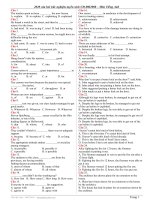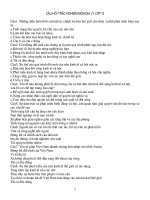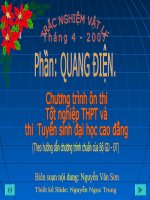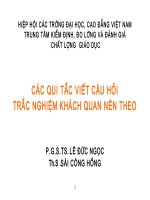Câu hỏi trắc nghiệm international trading
Bạn đang xem bản rút gọn của tài liệu. Xem và tải ngay bản đầy đủ của tài liệu tại đây (95.11 KB, 43 trang )
Chapter 1: Introduction to International trading
1. International trade is the exchange of goods and services within domestic
borders.
Answer: False. It is the exchange of goods and services across national
boundaries.
3. A recent study on wages and trade found a negative correlation between export
intensity and wages.
Answer: False. A positive correlation was found.
5. Export-related wages are higher in the service sector than in manufacturing.
Answer: False. They are higher in manufacturing.
8. Large countries tend to be more dependent on international trade than smaller
countries.
Answer: False. Smaller countries are more dependent since they do not have a
diversified economy.
10. Global imbalances may be reduced by a reduction in excess savings.
Answer: True.
MULTIPLE CHOICE
2. Which of the following are included in a typical services export?
a. Tourism and transportation
b. Sales and forecasting
c. Technology and e-commerce
d. All of the above
Answer: A
3. Who does international trade allow to seek out products, services, and
components in foreign countries?
a. Manufacturers and distributors
b. Distributors and suppliers
c. Suppliers and public officials
d. Manufacturers and suppliers
Answer: A
4. For developing countries, determinants of import demand include:
a. Government restrictions on all exports
b. Government restrictions on imports
c. Government restrictions on commercial exports only
d. Government restrictions on gold shipments
Answer: B
6. Which technologies assisted with the physical integration of world markets?
a. Media
b. E-commerce
c. a and b
d. None of the above
Answer: A
7. Which of the following explains the reason why larger countries import less
manufactured goods on a per capita basis?
a. Larger countries have a diversified economy, so goods produced are usually
outsourced.
b. Larger countries have the land capacity and ability to produce their own goods.
c. Larger countries have a larger population to help produce their own goods, thus
contributing to a diversified economy.
d. Larger countries have a diversified economy and export more services than
manufactured goods.
Answer: C
8. Trade in manufactured goods:
a. Has been a dynamic component of world merchandise trade
b. Has been a dynamic component of developed countries’ trade with the rest of the
world
c. Has been the fastest growing part of world trade
d. Is now dominated by China, Korea, and Canada
Answer: A
10. Unsustainable global imbalances have been a result of:
a. Weak currencies, domestic economic growth, and high savings
b. Strong currencies, domestic economic growth, and high savings
c. Weak currencies, domestic economic growth, and low savings
d. Strong currencies and domestic economic growth only
Answer: A
12. The major benefits of trade include:
a. Reduction in transportation cost
b. Increases in incomes and employment
c. Advances in technical methods
d. b and c
Answer: D
13. Faster growth in emerging economies:
a. Has resulted in higher inflation
b. Has reduced globalization efforts
c. Has put pressure on the supply of raw materials
d. Has reduced global imbalances
Answer: C
14. Which of the following will help in improving the U.S. balance of trade?
a. Trade in soybeans
b. Increasing manufactured goods’ exports
c. Increasing the share of exports by small and medium-sized businesses
d. All of the above
Answer: C
21. What has been the major focus of developing countries with regard to
trade?
a. Increase international trade
b. Increase production and exports
c. Demand tariff cuts by wealthy countries
d. Increase trade aid
Answer: B
23. Today’s integration of the world economy is driven by advances in, and to
reduce obstacles to the flow of trade and capital.
a. Communications, trade agreement, and government’s policy
b. Communications, information technology, and trade agreements
c. Communications, information technology, and government’s policy
d. Trade agreements, information technology, and government’s policy
Answer: C
24. Most occupations show a from an equal amount of exports and imports
except for occupations, which are shrinking in most countries because of lowwage imports.
a. Net loss, white-collar, developed
b. Net gain, blue-collar, developed
c. Net gain, blue-collar, developing
d. Net loss, white-collar, developing
Answer: B
25. Exports create:
a. Low wage employment
b. High wage employment
c. No increase or decrease in employment
d. None of the above
Answer: B
Chapter 2. International & Regional Agreements
1.The GATT in theory was an organization in which participating nations were
called “contracting parties.”
Answer: False. GATT was not an organization.
3. According to NAFTA, Mexico is allowed to place temporary capital limits for
banks, securities firms, and insurance companies during a transition period.
Answer: True.
4. NAFTA requires members to provide ninety days notice before adapting new
standards and allowing for comments before implementation.
Answer: False. NAFTA requires thirty days notice.
5. A common market includes elements of a customs union and allows for the free
movement of labor and capital among member nations.
Answer: True.
6. One of the objectives of the European Union is to abolish restrictions on the free
movement of all factors of production, including labor, services, and capital.
Answer: True.
7. NAFTA provides for a common external tariff.
Answer: False. It does not provide for a common external tariff.
8. The European Union does not provide economic assistance to member states.
However, it allows for economic/monetary union.
Answer: False. It does provide for economic assistance.
10. All trade agreements seek free trade and economic cooperation.
Answer: True.
MULTIPLE CHOICE
12. NAFTA has facilitated substantial increases of foreign direct investment in
which country?
a. United States
b. Canada
c. Mexico
d. All of the above
Answer: C
13. According to NAFTA, the qualification for preferential market access is
that goods must be within member countries.
a. Sold
b. Made
c. a and b
d. None of the above
Answer: B
14. Under NAFTA, disputes between member states are settled through:
a. Consultations
b. Conciliation
c. Panel of nongovernment experts
d. All of the above
Answer: D
17. Which of the following is not an objective of the European Union?
a. Establishment of free trade among nonmembers and member nations
b. Abolition of restrictions on the free movement of all factors of production
c. a and b
d. None of the above
Answer: A
18. The European Union has the following policy:
a. Uniform customs duties on goods imported from outside of the EU
b. The Common Agricultural Policy
c. Uniform common transport, agricultural and competition policy
d. All of the above
Answer: D
19. Which of the following is not an objective of the Single European Act?
a. Encouragement of monetary cooperation
b. Establishment of cooperation on research and development
c. Harmonization of working conditions across member nations
d. All of the above
Answer: D
20. The Euro has allowed for:
a. Higher transaction costs
b. Lower transaction costs
c. Nontransparent prices
d. a and c
Answer: B
Chapter 3. Planning and Preparations for Export
1.Factors that firms must consider before exporting their products overseas include
the success of the product in the domestic market, participation in overseas trade
shows, and advertising and market data.
Answer: True.
2. The reactive approach involves the selection of a product or service based on
overall market demand.
Answer: False. The systematic approach involves this.
3. International market assessment is a form of environment scanning that permits
a firm to select a large number of desirable markets on the basis of broad variables.
Answer: False. International market assessment is a form of environment scanning
that permits a firm to select a small number of desirable markets on the basis of
broad variables.
7. Commercial banks provide market research and promotion, financing exports,
collections, credit information, and assistance.
Answer: False. Market research and promotion is a characteristic of trading
companies.
8. Foreign media, commercial publications, and personal selling are ways that
exporters can advertise their product or service overseas.
Answer: True.
9. Important factors to consider in selecting the export product include shifting
spending patterns and emphasis on niche marketing.
Answer: True.
10. Trade missions are another import sales promotion tool.
Answer: False. They are only an export sales promotion tool.
MULTIPLE CHOICE
1. Uncontrollable environmental forces include:
a.
Exchange controls
b.
Taxation
c.
Inflation
d.
All of the above
Answer: D
2. Provide a preliminary indication of markets for a particular product in
most countries.
a. Trade statistics
b. Foreign investment data
c. Statistical data
d. Data measurements
Answer: A
3. The difference between a systematic approach and a reactive approach is:
a. The systematic approach involves the selection of a product based on immediate
market need, whereas the reactive approach is based on overall market demand.
b. A systematic approach involves the selection of a service based only on
immediate market need, whereas a reactive approach is based on the selection
based on overall market demand.
c. A systematic approach involves the selection of a product and service based on
overall market demand, whereas a reactive approach is based on the selection on
the basis of immediate market demand.
d. None of the above
Answer: C
4. In both cases (systematic or reactive), selection of the manufacturer
(supplier) depends on a number of factors including:
a. Price
b. Quality and reliability
c. Proximity to home or office
d. All of the above
Answer: D
5. Lack of focus on a given product or market and absence of a long-term
relationship with an importer are disadvantages of using:
a. Systematic approach
b. Reactive approach
c. a and b
d. None of the above
Answer: B
6. Which of the following are important factors to consider in selecting the
export product?
a. Shifting spending patterns
b. Products to be included from the list
c. Emphasis on quantity and niche marketing
d. All of the above
Answer: A
7. International market research is needed because:
a. Export/investment decisions are often made with careful assessment of foreign
markets and with a wide appreciation for different environments abroad.
b. Export/investment decisions are often made without careful and subjective
assessment of foreign markets and with a wide appreciation for different
environments abroad.
c. Export/investment decisions are often made without careful and objective
assessment of foreign markets and with a limited appreciation for different
environments abroad.
d. Export/investment decisions are often made without careful and objective
assessment of foreign markets and with a wide appreciation for different
environments abroad.
Answer: C
8. The purpose of international marketing research is to:
a. Identify and compare the size and potential of various markets and select the
most desirable market for a given product or service
b. Reassess market changes that may require changes in a company’s strategy
c. a and b
d. None of the above
Answer: C
12. Countries with high inflation rates should be carefully considered because
they may limit:
a. The volume of imports by restricting the availability of foreign exchange
b. The volume of exports by restricting the availability of foreign exchange
c. The volume of money supply by restricting the availability of foreign exchange
d. The volume of exports, imports, and money supply by restricting the availability
of foreign exchange
Answer: A
13. Exporting and importing of goods to and from politically unstable
countries can be affected by:
a. Entry barriers
b. Limits on foreign remittances and/or ownership
c. Taxes and price controls
d. All of the above
Answer: D
14. The structure of an international business plan includes:
a. Executive summary
b. Financial plan
c. Target market
d. All of the above
Answer: D
17.Which of the following is not a tool used by exporters for overseas
promotions?
a. Indirect mail
b. Trade missions
c. Advertising
d. All of the above
Answer: A
18. In Southeast Asia, what is the most effective way of promoting the sale of
industrial goods?
a. Advertising
b. Trade missions
c. Direct mail
d. Personal selling
Answer: C
20. Trade fairs can be organized by:
a. Certain industries
b. Trade associations
c. Chamber of Commerce
d. All of the above
Answer: D
22. ….is communicating with an audience by personal or non-personal media
that are not explicitly paid for delivering messages.
a. Personal selling
b. Sales promotion
c. Publicity
d. The Internet
Answer: C
24. Which of the following is not a common mistake made by potential
exporters?
a. Failure to obtain qualified export counseling
b. Failure to print service, sale, and warranty messages in locally understood
languages
c. Failure to provide readily available servicing for the product
d. Neglecting import business when the U.S. market booms
Answer: D
25. Which of the following is not a factor in the export decision?
a. Experience
b. Human resource and personnel
c. Production capacity
d. Financial capacity
Answer: B
Chapter 4. International Logistics, Risk, and Insurance
1.The two categories of business logistics are materials management and physical
distribution.
Answer: True.
2. The interdependence of functional activities has been articulated through various
new approaches or concepts, including the systems approach, total cost approach,
and the trade approach.
Answer: False. It has not been articulated through the total cost approach, but
instead through the opportunity cost approach.
3. A major political risk in foreign trade includes nonpayment or delays in payment
for imports.
Answer: False. Nonpayment and delays are not political risks but are foreign
credit risks.
4. A letter of credit transaction avoids risks arising from late payments or bad debts
because it ensures that payments are made before the goods are shipped to the
importer.
Answer: False. A confirmed letter of credit does this.
5. Many export firms do insure trade receivables, including fire or car insurance.
Answer: False. Many export firms do not insure trade receivables.
6. The primary purpose of insurance in the context of foreign trade is to reduce the
financial burden of losses arising from the movement of goods over long distances.
Answer: True.
7. An all-risks policy covers total loss and partial loss from certain specified risks
insured against.
Answer: False. FPA (free of particular average)
8. The Inchmaree clause relieves the insurer of liability for partial cargo losses,
except for those caused by the stranding, sinking, burning, or collision of the vessel
with another.
Answer: False. The free of particular average clause protects against these events.
9. The typical steps in claim procedures include the preliminary notice of claim,
formal notice of claim, and the settlement of claim.
Answer: True.
10. Most developing countries provide insurance programs for their import firms to
cover losses due to political upheaval in their countries.
Answer: False. Most industrialized nations provide insurance programs for their
export firms to cover losses due to political risk.
MULTIPLE CHOICE
1. The total cost approach:
a. Considers a trade-off in undertaking certain logistics decisions
b. Is a logistics concept based on evaluation of the total cost implications of
various activities
c. Is a logistics concept based on the premise that the flow of materials within and
outside the firm should be considered only in the context of their interaction.
d. Is all of the above
Answer: B
2. ……applies to the timely movement of materials from the sources of supply
to the point of manufacture, assembly, or distribution.
a. Physical distribution
b. Materials management
c. Supply clusters
d. Logistical procedures
Answer: B
3. The development of advanced logistics systems and capabilities has also
increased efficient,…..,….and…..of products.
a. Production; transportation; distribution
b. Production; handling; supplying
c. Production; transportation; supplying
d. Production; handling; distribution
Answer: A
5. The pressures on firms to reexamine their logistics systems has been largely
due to:
a. The proliferation of new products and services
b. The changes in the local and state laws
c. The changes in the international laws
d. All of the above
Answer: A
6. A reexamination of logistics system helps firms:
a. Reduce inventory costs
b. Reduce transportation cost and delivery time
c. Reduce advertising expenditures
d. a and b
Answer: D
7. What factors influence the need for adequate packing of goods?
a. Breakage of goods, moisture, and theft
b. Faster transportation
c. Easier supervision
d. Easier containerization
Answer: A
8. ….and…. of cargo has the added advantage of synchronizing promotions
and long- term inventory decisions for customers.
a. Tracking; tracing
b. Tracking; servicing
c. Tracing; servicing
d. None of the above
Answer: A
9. Which of the following describes the difference between domestic logistics
and international logistics?
a. Domestic logistics requires products to be transported by truck or rail;
international logistics requires products to be transported by air or sea.
b. Domestic logistics has different national regulations and many intermediaries
participating in the distribution channel; international logistics requires the national
regulation on packaging and labeling.
c. a and b
d. None of the above
Answer: A
10. In a typical international logistics process, a pro-forma invoice prepared
by the seller:
a. May serve as a service contract
b. May serve as a sales contract
c. May be used to collect merchandise
d. May be used as a contract of shipment
Answer: B
12. In a typical logistics process, after the merchandise is transported, the
forwarder sends the necessary documents to:
a. The buyer
b. The customs broker
c. The shipper
d. The inspector in the buyer’s country
Answer: B
14. “Do not roll,” “keep frozen,” or “live animals” are examples of
appropriate:
a. Packing for certain products
b. Labeling for certain products
c. Inventory for certain products
d. Packing and labeling for certain products
Answer: B
18. Which logistics function includes the consolidation of small cargo,
documentation, and filing of loss and damage claims?
a. Inventory and storage
b. Traffic management
c. Packing
d. All of the above
Answer: B
19. In international logistics, the most expensive mode of transportation is:
a. Airfreight
b. Sea freight
c. Rail
d. Truck
Answer: A
20. Risks in foreign trade include:
a. War, terrorism, actions of legitimate government authorities to confiscate cargo
b. Non-payments or delays in payment for imports
c. Loss or damage to shipment during transit
d. All of the above
Answer: D
22. The different methods used to protect against foreign exchange risks
include:
a. Shifting the risk to third parties
b. Shifting the risk to the other party in an export contract
c. a and b
d. None of the above
Answer: C
23. The two types of marine cargo insurance policies are:
a. Perils-only policy and all-risks policy
b. Perils-only policy and marine-risk policy
c. Marine-risk policy and all-risks policy
d. Marine-risk policy and perils-only policy
Answer: A
24. Which form is required for the completion of such particulars as points of
shipment and destination, description of units, and amount of insurance?
a. Customs form
b. Air waybill
c. Declarations form
d. Bill of lading
Answer: C
26. Insurance certificates are used because:
a. They are less expensive.
b. Exporters tend to use them frequently.
c. They save time.
d. They are required by government agencies.
Answer: C
29. In most cases, shippers claim from:
a. Carriers
b. Insurers and carriers
c. Insurers
d. All of the above
Answer: C
Chapter 5. Pricing in International Trade
1.Export prices should be low enough to remain competitive in the market, yet
high enough to make reasonable profit.
Answer: True.
2. Parallel or gray markets are created when the product is purchased at a high
price in one market and sold in markets that enjoy higher prices.
Answer: False. Parallel or gray markets are created when the product is purchased
at a low price in one market and sold in markets that enjoy higher prices.
3. One of the external forces that influences export pricing is location and
environment of the foreign market.
Answer: True.
5. Under a CIF contract, when goods are lost or destroyed during transit the buyer
is entitled to claim the purchase price against presentation of proper shipping
documents to the seller.
Answer: False. Under a CIF contract, when goods are lost or destroyed during
transit the seller is entitled to claim the purchase price against presentation of
proper shipping documents to the buyer.
6. Common features shared by D terms include the arrival/destination terms,
seller’s requirement to arrange for transportation, and that Incoterms do not require
insurance during transportation.
Answer: True.
7. In arrival contracts, the buyer is under no obligation to pay the purchase price if
the goods are lost in transit. However, in CIF the buyer is required to pay against
documents.
Answer: True.
9. In cost-based pricing, the export price is based on the variable cost of producing
the product.
Answer: False. Not in cost-based pricing but in marginal pricing.
MULTIPLE CHOICE
2. Which of the following policies to pricing and markups apply to both
domestic and export markets?
a. High markups are common in industries with relatively large competitors.
b. High markups are common in industries with relatively few competitors.
c. Export prices tend to be relatively high in sectors where increased competition
exists.
d. All of the above
Answer: B
4. Which of the following is an external force that influences export pricing?
a. Supply and demand
b. Location and environment of the domestic market
c. Government regulations in the home country
d. All of the above
Answer: A
9. How often are Incoterms revised to represent contemporary commercial
practice?
a. Every 2 years
b. Every 5 years
c. Every 7 years
d. Every 10 years
Answer: D
11. Which of the following describes Group D terms?
a. The seller’s delivery obligation extends to the country of destination.
b. At the point of delivery, transfer of risk is from the seller to the buyer.
c. The seller is expected to bear the risk and expense of the delivery to a nominated
carrier.
d. All of the above
Answer: A
12. Under which term does the buyer or agent have to collect the goods at the
seller’s warehouse or store?
a. Ex warehouse
b. Ex store
c. Ex works
d. All of the above
Answer: D
13. In the Group E terms:
a. Risk is not transferred to the seller if damage or loss is attributed to the failure of
delivery
b. Risk is not transferred to the buyer if damage or loss is attributed to the failure
of delivery
c. The seller bears all risks and charges pertaining to pre-shipment inspection,
export/import licenses, and customs duties needed for exportation
d. All of the above
Answer: B
14. Under Free Carrier, the buyer has which of the following obligations?
a. Contract at his or her own expense for carriage of goods from the named place
of delivery
b. Pay the costs of any pre-shipment inspection except when such inspection is
mandated by the exporting country
c. Obtain an import license and other official documents at his or her own risk
d. All of the above
Answer: D
15. The central feature of contracts is the notion that the seller undertakes to
place the goods on board the ship designated by the buyer.
a. FAS
b. CIS
c. FOB
d. CIP
Answer: C
16. The contract places on the obligation to arrange for shipment of the goods.
a. FOB; seller
b. CIF; seller
c. FOB; buyer
d. CIF; buyer
Answer: B
17. The CPT term is similar to the CIP term, except that:
a. The seller is not required to arrange or pay for insurance coverage of goods
during transportation.
b. The seller is required to arrange or pay for insurance coverage of goods during
transportation.
c. The buyer is not required to arrange or pay for the insurance coverage of goods
during transportation.









